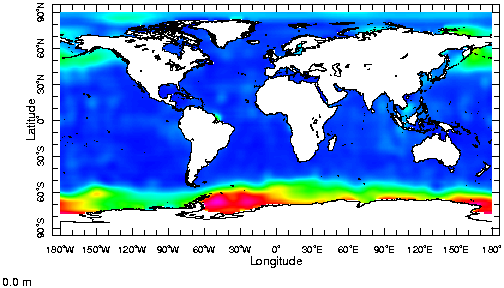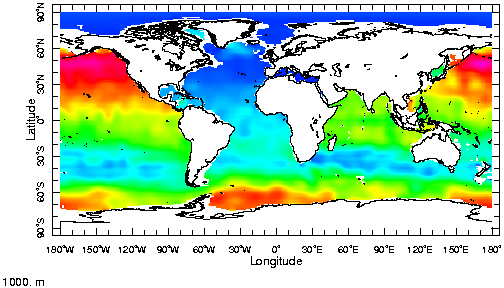
Dissolved silica
Encyclopedia
Dissolved silica is the form of water soluble silica as silicon
hydroxide
(equivalent to the old term silicic acid
), which can be measured by standard analyses (e.g. Strickland and Parsons, 1972). However, The term dissolved silica is different from the silicate occurring as silicate minerals
, which is a class of minerals forming rings, sheets, chains, and tetrahedrons. Likewise, the term dissolved silica is different from the term silicone
, which is organic polymers of silicon
.
There exist three different species of DSi in natural waters:
Marine diatoms transport Si(OH)4 (DelAmo and Brzezinski, 2000).
In the uppermost water column the surface ocean
is undersaturated with respect to DSi, except for the Antarctic Circumpolar Current
south of 55°S.

DSi is regenerated with increasing water depth, and DSi values increase along the conveyor belt from the Atlantic over the Indian into the Pacific Ocean.


Those figures have been drawn using the interactive web site which feeds on annual DSi values from LEVITUS94: World Ocean Atlas
1994, an atlas of objectively analyzed fields of major ocean parameters at the annual, seasonal, and monthly time scales. Superseded by WOA98. Edited by Syd Levitus.
Silicon
Silicon is a chemical element with the symbol Si and atomic number 14. A tetravalent metalloid, it is less reactive than its chemical analog carbon, the nonmetal directly above it in the periodic table, but more reactive than germanium, the metalloid directly below it in the table...
hydroxide
Hydroxide
Hydroxide is a diatomic anion with chemical formula OH−. It consists of an oxygen and a hydrogen atom held together by a covalent bond, and carrying a negative electric charge. It is an important but usually minor constituent of water. It functions as a base, as a ligand, a nucleophile, and a...
(equivalent to the old term silicic acid
Silicic acid
Silicic acid is a general name for a family of chemical compounds of the element silicon, hydrogen, and oxygen, with the general formula [SiOx4-2x]n...
), which can be measured by standard analyses (e.g. Strickland and Parsons, 1972). However, The term dissolved silica is different from the silicate occurring as silicate minerals
Silicate minerals
The silicate minerals make up the largest and most important class of rock-forming minerals, constituting approximately 90 percent of the crust of the Earth. They are classified based on the structure of their silicate group...
, which is a class of minerals forming rings, sheets, chains, and tetrahedrons. Likewise, the term dissolved silica is different from the term silicone
Silicone
Silicones are inert, synthetic compounds with a variety of forms and uses. Typically heat-resistant and rubber-like, they are used in sealants, adhesives, lubricants, medical applications , cookware, and insulation....
, which is organic polymers of silicon
Silicon
Silicon is a chemical element with the symbol Si and atomic number 14. A tetravalent metalloid, it is less reactive than its chemical analog carbon, the nonmetal directly above it in the periodic table, but more reactive than germanium, the metalloid directly below it in the table...
.
There exist three different species of DSi in natural waters:
- SiO2(OH)22-
- SiO(OH)3-
- Si(OH)4
Marine diatoms transport Si(OH)4 (DelAmo and Brzezinski, 2000).
In the uppermost water column the surface ocean
Ocean
An ocean is a major body of saline water, and a principal component of the hydrosphere. Approximately 71% of the Earth's surface is covered by ocean, a continuous body of water that is customarily divided into several principal oceans and smaller seas.More than half of this area is over 3,000...
is undersaturated with respect to DSi, except for the Antarctic Circumpolar Current
Antarctic Circumpolar Current
The Antarctic Circumpolar Current is an ocean current that flows from west to east around Antarctica. An alternative name for the ACC is the West Wind Drift. The ACC is the dominant circulation feature of the Southern Ocean and, at approximately 125 Sverdrups, the largest ocean current...
south of 55°S.

DSi is regenerated with increasing water depth, and DSi values increase along the conveyor belt from the Atlantic over the Indian into the Pacific Ocean.


Those figures have been drawn using the interactive web site which feeds on annual DSi values from LEVITUS94: World Ocean Atlas
World Ocean Atlas
The World Ocean Atlas is a data product of the Ocean Climate Laboratory of the National Oceanographic Data Center . The WOA consists of a climatology of fields of in situ ocean properties for the World Ocean...
1994, an atlas of objectively analyzed fields of major ocean parameters at the annual, seasonal, and monthly time scales. Superseded by WOA98. Edited by Syd Levitus.

